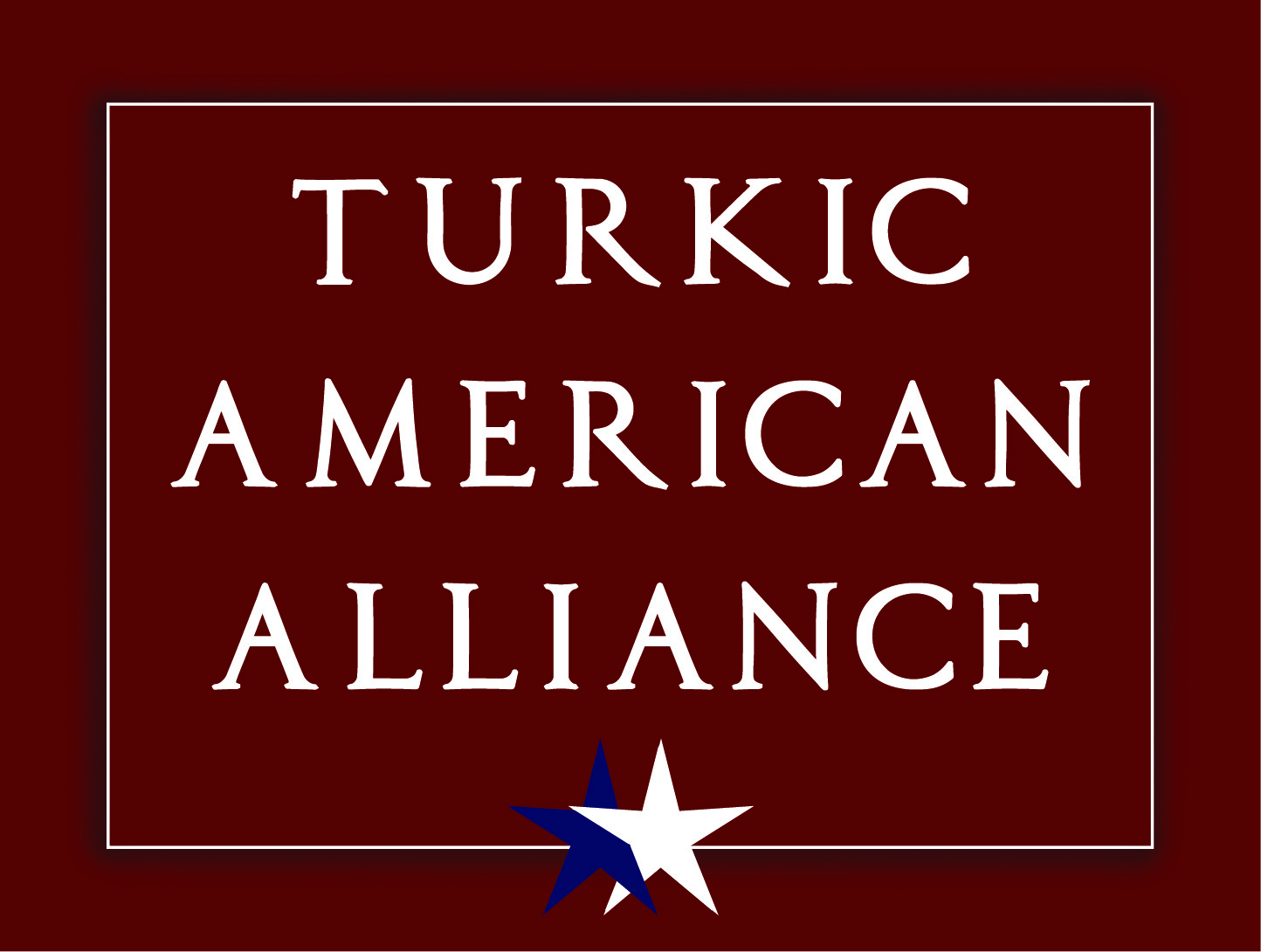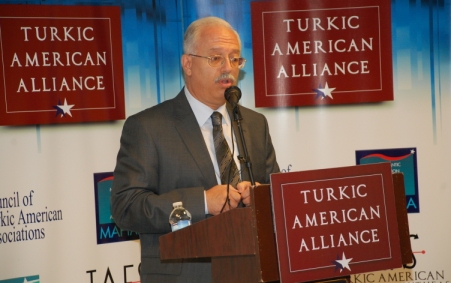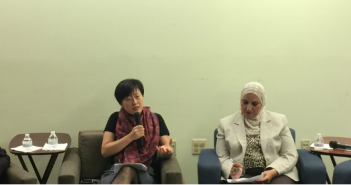Today, H.E. Ahmet Erdengiz, Washington Representative of The Turkish Republic of Northern Cyprus spoke at the TAA. His topic was “Cyprus: Two Peoples on One Island”.The Cyprus Issue began in 1963. It has passed through many phases, but always defying solution. After 6 U.N. Secretary-Generals and 9 U.S. Presidents and 44 years of intermittent negotiations it still eludes a solution. Why? There is certainly no lack of expertise, knowledge or skill at the negotiating table and at requisite times
there was no shortage of international interest, assistance and even pressure. Yet the vicious circle of failurepersists. Who created this political aberration and why? And why does this ghost stillhaunts the hallow halls of the U.N., the U.S. Congress and the European Parliament? The answer to this conundrum lies at its inception.
H.E. Ahmet Erdengiz:
TWO PEOPLES AND A U.N. RESOLUTION
Professor Gabriel Salomon and Daniel Bar-Tal once described the intractable conflicts as those that are protracted irreconcilable, violent, of zero-sum nature, total and central where parties involved invest their major resources in such conflicts.
The Cyprus conflict started in mid-1950’s as a communal confrontation between the Greek Cypriots and Turkish Cypriots living under British colonial rule and evolved into a full-blown conflict after the collapse of the partnership republic of Cyprus in 1963.
Since then it has passed through many phases, but always defying a solution. After 6 UN secretaries general, 9 US presidents and 44 years of intermittent talks it still eludes a solution and seems as irreconcilable and intractable as ever why?
Yet the vicious circle of failure persists.
Why the basic and minimum existential needs of the Turkish Cypriot people always seem to exceed the Greek Cypriots’ maximum concessions? Why does the Greek Cypriot side perceive the issue as being of zero-sum nature, employed violence in the past and has been mobilizing all its possible resources within and without and whenever possible the international community in order to win it?
In order to answer these questions and comprehend the crux of the Cyprus problem, i will take you to a journey through the pages of Cypriot history. Our historical travel will begin sometime in September 1571 and end in March 1964. After traversing almost 400 years of Cyprus’ history, I hope, we shall find, at least, some answers.
Although the Turks were not entirely aliens to the inhabitants of medieval Cyprus, since Turkish merchants called at the ports of the island and Cyprus had already become a tributary state to Ottoman Empire while still under Venetian rule, the Greek Cypriots and Turks met en masse in 1571 following the capture of the island by the ottoman Turks.
For the benefit of American audience and in the words of eminent American scholar Prof. Pierre Oberling, allow me to say that, this was well before the pilgrims landed at Plymouth and the establishment of Jamestown colony.
Greek Cypriots welcomed the ottoman Turks on the island as saviors since almost 400 years of French and Venetian rules of Cyprus had reduced the Greek Cypriots to state of complete serfdom.
 As landless paupers while they were oppressed by their feudal lords, their church, the orthodox church of Cyprus, was subjugated to the Catholic Church, losing its independence, religious authority and economic resources.
As landless paupers while they were oppressed by their feudal lords, their church, the orthodox church of Cyprus, was subjugated to the Catholic Church, losing its independence, religious authority and economic resources.
A papal edict in 1260 abolished the office of the orthodox archbishop and remaining Greek Cypriot priests were made subservient to Latin prelates of the island.
On May 6, 1572, Ottoman Sultan Selim II issued an imperial firman ordering the new governor-general of the island to return the lands of Greek Cypriots confiscated by the venetians and permit the reestablishment of the orthodox archbishopric. This new arrangement created in essence a semi – autonomous community in charge of its own church, education, collecting ecclesiastical taxes and courts dealing with cases involving marriage, divorce, inheritance and civil rights.
Furthermore, in order to boost the depleted population of the island and its economy Sultan Selim ordered the transfer of Turkish peasants, share croppers, shepherds, craftsmen and artisans from Anatolia on September 21, 1572.
Prof. Pierre Oberling makes the following important observation:
“As a result of these population transfers, Turks from a wide variety of professional backgrounds made their way to the island. In this respect, the process of colonization carried out by the Turks in Cyprus was similar to that British in North America. But an important difference was that the Turks made a wholehearted effort to integrate the local inhabitants into the economic and political life of the ottoman empire while allowing them to retain their own social institutions and cultural identity, whereas in the new world the Indians were simply pushed aside as impediments to the fulfillment of white man’s dreams…
Finally, it is worth noting that the ottoman government never attempted to establish a Turkish majority on Cyprus. Nor did it seek to set up an economically dominant upper class… under the Turkish rule; Greek Cypriots controlled the island’s principle business enterprises, especially those concerned with manufacturing and trade.”
Thus began the common history of the Turkish Cypriots and Greek Cypriots, common yet distinct. Let us pause and recapitulate: as off third quarter of the 16. Century, Cyprus now had two major, distinct populations, Greek Cypriots who claimed to be remnants of ancient Greeks, spoke Greek and belonged to the orthodox church and Turkish Cypriots, offshoots of Turkomans of Anatolia, spoke Turkish and mainly belonged to the Alewite sect of Islam in the rural areas and Sunni sect of Islam in urban areas. While in towns each community lived in its separate quarters, in rural areas 2 types of settlements emerged in time. In most cases Greek Cypriot and Turkish Cypriots lived in ethnically homogeneous and in some cases ethnically mixed villages.
Yet even in mixed villages Greek Cypriots and Turkish Cypriots lived in their distinct quarters.
In his article “Turks and Greeks of Cyprus: psychopolitical considerations” eminent professor of psychiatry Vamik Volkan, summarizes the relationship between the two peoples of the island under ottoman and British rule, roughly encompassing three hundred years:
“Under the ottomans and British, an external power controlled the two communities so that they could do nothing but live ‘together’… and outside of a few incidents, the two communities shared the island in a seemingly peaceful fashion. Consequently, what was established over the centuries was a Cypriot culture based on two communities, and therefore, a psychological duality. The Turks and Greeks intermingled physically, but their major differences of religion and language protected respective identities. In order to further protect their identities, however, this dual culture also sanctioned certain rituals. For example, intermarrying between the two groups became a taboo as severe as incest.”
One can add the issue of separate economic structures to professor Volkan’s observations. Between 1572 and 1974, history records no joint economic ventures among the members of the two communities. Turkish Cypriot and Greek Cypriot capital only came together in the coffers of the Barclay’s bank which opened branches in Cyprus during the British rule.
As indicated by professor Volkan, under the protective umbrella of the ottomans and then the British two peoples lived in peace. And as in any multi-ethnical society and geographical region Greek Cypriots and Turkish Cypriots participated in each other’s social events such as weddings, funerals and festivities. They worked as hired laborers for each other and traded in local village markets.
Yet Cyprus proved to be no melting pot. Nearly four hundred and fifty years of co-existence on a small island did not produce a nation. When it came to integration and nation building Cyprus was certainly not USA. In other words there exists no Cypriot nation, no Cypriot language and no Cypriot religion. In the infamous but true words of former Greek Cypriot leader Makarios “only the donkeys of Cyprus can be called real Cypriots, rest are Greeks and Turks.”
For the next 250 years Cyprus remained basically peaceful and the relationship between the two peoples undisturbed. However, with the arrival of nationalism in Greece at end of 18. and beginning of 19 century through Greek merchants stationed in the major commercial centers of Europe and philhellenic movements started by the European liberal intellectuals influencing the Greek intelligentsia, the fate of Cyprus, thousands of miles away from the Greek mainland was about to change.
Nationalism rapidly caught on in the Greek provinces of Ottoman Empire which culminated in the Greek revolt of 1821. Ottoman Empire reluctantly granted independence after Russia and other European powers threatened to dismember the ailing empire.
However, what started as liberal nationalism and philhellenic ideals soon transformed itself into a barbaric and ruthless version. Ten of thousands of Turks then living in Greece were massacred within few months.
In his monumental treatise on the Greek war of independence, the Greek historian Spyridon Trikoupis, describes the carnage:
“the day of the seizure of the Pelopponesian capital was the day of destruction, fire, pillage and blood. Men, women, children all perished, some with their throats cut, some thrown into the flames… these scenes lasted for three days. On the third, those who had fled the city…were slaughtered in the countryside.”
Even philhellen author William st. Clair, in his book ‘that Greece might still be free’ was forced to acknowledge the carnage:
“the Turks of Greece left few traces. They disappeared suddenly and finally in the spring of 1821 unmourned and unnoticed by the rest of the world… upwards of twenty thousand Turkish men, women and children were murdered by their Greek neighbors in a few weeks of slaughter.”
It was this fierce and violence-laden version of Greek nationalism and not the nationalism of westernized Greek intellectuals and European philhellens exported to Cyprus. Dreams to reestablish the former glory of ancient Greece was soon forgotten thanks to Greek Orthodox Church and nationalist agenda was redrafted to recreate orthodox Byzantium.
Prof. Pierre Oberling in his monography ‘the double representation conspiracy’ summarizes this transformation as follows:
“As the heady wine of religious passion mixed with the already intoxicating nectar of political nationalism, it became inevitable that the Greek war of independence would turn into a religious crusade.”
He then quotes professor dennis skiotis of Harvard university:
“With savage jubilance, the Greeks sang the words ‘let no turk remain in the morea, nor inthe whole world.’ the Greeks were determined to achieve romaic (that is byzantine)restoration in the only way they knew how: through a war of religious extermination.”
The political scientist Harry Anastasiou in his two volume work ‘the broken olive branch’ makes the following observations as regards the historically untenable romaic, that is byzantine version of Greek nationalism which still dominates the general ideology of the orthodox church of Cyprus, the Greek Cypriot nationalist thinking and politics and constitutes one of the pillars of Greek Cypriot education:
“Yet, any serious inquiry reveals that the concept of a Greek nation, let alone a Greek nation-state, was completely absent from the Byzantine Empire. Historically the leaders and populace of the Byzantine Empire saw their world as a continuation of the ideal of imperial Rome, to which institutionalized Christianity was the new attachment. The byzantine world was in fact a multiethnic empire, in which both the imperial leaders and their subjects saw themselves not as ethnocentric Hellenes but primarily as Romans. This was so even after the literate elites used Greek as a language of letters. A crucial fact ignored by Greek nationalist historiography is that Justinians’ wars aimed at restoring the boundaries of the old Roman Empire, while he, himself, did not even speak Greek.”
The resultant of this historically undefendable factoid was the infamous megali idea or great idea which was to figure very prominently in shaping the Greek Cypriot politics in the 20. Century and ultimately create the intractable Cyprus issue. In its most restraint version it meant the reestablishment of Byzantine Empire, in its broader version it meant the recreation of the empire of Alexander the great.
Despite their repeated defeats by the ottomans after 1821 and finally by the forces of Mustafa Kemal Ataturk megali idea persisted among the Greeks mainly thanks to Greek orthodox church.
Echoing the words of premier eleftherios Venizelos in 1920 who promised his countrymen a “Greece of two continents and five seas”, Premier George Papandreou, in a speech delivered at Salonica on October 27, 1964 declared: “Cyprus must become the springboard for the dreams of Alexander the great in the orient.”
With the rise of nationalism during the 19. and early 20. century among the Greek Cypriots, the orthodox church of Cyprus began to function as the most powerful and organized agent of nationalist agitation and mass mobilization.
The great idea which constituted the staple of Greek Cypriot education which was mainly ran by the Orthodox Church under the ottomans became the main driving force of Greek Cypriot politics following the British take over of the island in 1878. Aided and abetted by Greece and encouraged and often bank rolled by the orthodox church Greek Cypriot nationalist organizations and leaders maintained a steady level of agitation and in one case engineered an open revolt in the capital for the unification of the island with Greece, that is enosis.
Greek Cypriot nationalism reached its zenith by the election of Michael Muskos as archbishop of Cyprus who on the occasion of his enthronement as makarios iii on October 20, 1950, stated: “I take the holy oath that i shall work for the birth of our national freedom and shall never waiver from our policy of uniting Cyprus with mother Greece.”
Greek Cypriot megali idea and enosis as formulated by arcbishop makarios meant the exclusion, subjugation and when necessary the elimination of the Turkish Cypriot people in order to achieve this ultimate goal.
By the time British had granted independence to Cyprus and the bi-communal partnership republic of Cyprus was established in 1960, it became abundantly clear that Greek Cypriots considered the new republic a mere stepping stone to annex the island with Greece and forcefully impose its will onto the Turkish Cypriot people to create a pure ethnocentric state at the expense of tearing apart the natural multiethnic fabric of the island.
After all it was archbishop makarios, following his election to the presidency of Cyprus, declared in a sermon he gave at his native village of Panaya that the struggle of the Greek Cypriot freedom fighters shall not be considered as completed until the last remnants of the enemy of Hellenism, the Turkish Cypriot were expelled from the island.
As tide of Greek Cypriot nationalism grew bigger and stronger the number of ethnically mixed villages and towns on the island declined. Under ottomans and during the first three decades of British rule the number of mixed villages was 234, by 1921 the number fell to 221, the number declined to 202 following the Greek Cypriot revolt of 1931, by the end of world war ii the number dwindled to 161, by the time of the establishment of the bi-communal republic of Cyprus in 1960 the number was 102, by 1974 only 48 mixed villages were left. Currently a single mixed village exists in the British sovereign military base of Dikelia.
By 1963, the Greek Cypriot leadership dropped all the pretenses and began openly declaring its real aim. In a public statement which was widely quoted by the press archbishop makarios declared:
“No Greek who knows me can ever believe that I wish to work for the creation of a Cypriot national awareness. The agreements have created a state, but not a nation. The aim of the Cyprus struggle was not the establishment of a republic. These agreements only laid the foundation for the unification of the island with Greece.”
Greek Cypriots exploited the intervening three years between 1960 and 1963 to arm themselves and create paramilitary organizations. Millions of dollars channeled by Greece and Orthodox Church spent in purchasing Russian arms through Czechoslovakia and Egypt. Secretly smuggled Greek officers undertook the training. The pitch of Greek Cypriot nationalist propaganda was raised to all time high. Greek Cypriots now openly declared that Cyprus was Greek and no other race other than Greeks could inhabit the island.
Makarios declared:
“Cyprus is Greek. Cyprus was Greek since the dawn of history, and will remain Greek. Greek and undivided we have taken it over. Greek and undivided we shall preserve it. Greek and undivided we shall deliver it to Greece.”
Even today, makarios’ ghost still haunts the Greek Cypriot politics, culture and education system. After nearly fifty years the above dictum continues to shape the Greek Cypriot politics and Greek Cypriot thinking vis a vis the Turkish Cypriots. Whatever is not Greek on the island is second class and not certainly on par with the Greek Cypriots. It is this belief that compels the Greek Cypriots to reject the idea of having a Turkish Cypriot as president of Cyprus in a future settlement.
Finally, the Greek Cypriot attacks came on December 21, 1963. In his memoirs, Cyprus: my deposition, glafkos clerides, president of the Greek Cypriot state between 1993-2003, offers the following analysis of the roots of the Cyprus problem:
“just as the Greek Cypriot preoccupation [after the establishment of the republic of Cyprus in 1960]was that Cyprus should be a Greek Cypriot state, with a protected Turkish Cypriot minority, the Turkish preoccupation was to defeat any such effort and to maintain the partnership concept, which in their opinion the zurich agreement [of 1959]created between the two communities. The conflict, therefore, was a conflict of principle and for that principle both sides were prepared to go on arguing and even, if need be, to fight, rather than compromise.”
As a result of ferocious Greek Cypriot attacks between 21 December 1963 and 18 February 1964 thousands of Turkish Cypriots were killed, wounded and abducted never to be seen again. More than 100 villages were destroyed and nearly 75% of the Turkish Cypriots become refugees and were forced to live in 33 small enclaves, encircled by Greek Cypriot paramilitary units, as Newsweek correspondent ward just described some of them “not much larger than Yankee stadium” of New York.
Professor Michael Moran calls 1964 as “one of the most eventful, indeed fateful, year in the history of modern Cyprus.” This is indeed a correct and apt analysis for events that took place and the subsequent decisions made in March 1964 in New York, thousands of miles away from Cyprus, sealed the fate of Cyprus and condemned all the future efforts to find a negotiated settlement to Cyprus problem to failure.
By February 1964 Turkish Cypriots were driven out of all organs of the state. Turkish Cypriot members of the parliament, judges, bureaucrats and ministers were all excluded from their offices by force of arms.
On February 12, George Ball, the United States under secretary of state, arrived in Nicosia in an attempt to stop the massacre of the Turkish Cypriots and persuade the Greek Cypriots to accept the stationing of a NATO peace-keeping force in Cyprus. His meeting with archbishop makarios proved futile. The much- exasperated American diplomat wrote the following in his memoirs ‘past has another pattern’:
“Three or four vignettes of my Cyprus days stand out sharply in my memory. A massacre took place in limassol on the south coast in which, as i recall, about fifty Turkish Cypriots were killed- in some cases by bulldozers crushing their flimsy houses. As makarios and i walked out of the meeting together on the second day, i said to him sharply that such beastly actions had to stop, that the previous night’s affair was intolerable, and that he must halt the violence. With amused tolerance, he replied, ‘but Mr. Secretary, the Greeks and Turks have lived together for two thousand years on this island and there have always been occasional incidents; we are quite used to this.’ I was furious at such a bland reply. ‘your beatitude,’ I said, ‘I’ve been trying for the last two days to make the simple point that this is not the middle ages but the latter part of the twentieth century. The world’s not going to stand idly by and let you turn this beautiful little island into your private abattoir.’ instead of the outburst I had expected, he said quietly, with a sad smile, ‘oh, you’re a hard man, Mr. Secretary, a very hard man!’
Makarios’s central interest was to block off Turkish intervention so that he and his Greek Cypriots could go on happily massacring Turkish Cypriots. Obviously we would never permit that. ‘the Greek Cypriots’ I wrote, ‘do not want a peacekeeping force; they just want to be left alone to kill Turkish Cypriots.’”
By 1964 without its Turkish Cypriot members, all three branches of the Cyprus state, namely executive, legislative and judiciary became unconstitutional. In effect Greek Cypriots hijacked the bi-national republic of Cyprus and turned it into a solely Greek Cypriot administration purporting to represent the whole island and its two peoples.
At this point we have to pause and ask: What happened during that fateful month of March that the usurper Greek Cypriot administration came to be recognized as the government of Cyprus and Turkish Cypriots were divested of their constitutional rights and partnership status?
Under – secretary ball’s failed visit to Cyprus between February 12-15 was followed by another wave of violent Greek Cypriot attacks. John law the correspondent of us news and world report describes the aftermath of one of those savage attacks:
“my first view of the Turkish quarter was not a pretty sight. Houses were riddled with gapping holes. Whole walls had been blasted off many of them. There were many dead-some still lying where they had been killed.
The Turks didn’t know how many had been killed during the day because they had not been able to collect their dead.”
The observer correspondent Michael Durant concluded his report of Greek Cypriot carnage with the following sentence:
“I have visited houses in the Turkish quarter which are almost carpeted with blood.”
Giorgio Bocca correspondent of Italian newspaper il giorno who witnessed the destruction of 55 Turkish Cypriot villages during the month of January described the destruction and violent attacks on some of those Turkish Cypriot villages:
“Right now we are witnessing the exodus of the Turks from their villages. Thousands of people abandoning homes, lands, herds; Greek terrorism is relentless. This time, the rhetoric of the Hellenes and the busts of Plato do not suffice to cover up barbaric and ferocious behavior. At four o’clock in the afternoon, curfew is imposed on the Turkish villages. Threats, shootings and attempts at arson start as soon as it becomes dark. After the massacre of Christmas that spared neither women nor children, it is difficult to put up any resistance.”
Towards the end of February and following the failure of British sponsored London conference to end the massacres, it became apparent that the only alternative was to send an un peace- keeping force to Cyprus. Despite pro-Greek Cypriot soviet Russia’s and other socialist countries’ objections US and the British submitted a draft resolution to that effect.
The final draft of the resolution 186 submitted to the approval of the security council on march 4, 1964, among other things asked the government of Cyprus, to take all additional measures necessary to stop violence and bloodshed in Cyprus and recommended the creation, with the consent of the government of Cyprus, of a united nations peace-keeping force on the island.
In other words not only the perpetrators of carnage in Cyprus was asked to provide for the security of Turkish Cypriots, but unconstitutional Greek Cypriot administration was recognized as the legitimate government of Cyprus and put in charge on the island. It also indirectly relegated the co-founder and constitutionally equal partner of the republic, the Turkish Cypriots, to the preposterous position of “minority.”
But what made turkey and Turkish Cypriots to drop their initial objections to the wording of this fateful resolution? Late president Rauf Denktas, who was in New York at the time and despite Greek and Greek Cypriot objections managed to address the Security Council, albeit in the diminished status of “interested individual”, offered the following explanation in his memoirs:
“The Turkish mission and I objected to the wording of the draft agreement [which eventually became the accepted UN resolution of March 4th, 1964]on the ground that makarios would take full advantage of it. We stalled the passing of this draft for about a week. American and British diplomats assured us that the word ‘government’ in this draft meant the constitutional, bicommunal government. ‘It is the security council which will interpret this resolution’, they said. ‘Don’t waste time…it is Turkish Cypriot blood which is flowing in Cyprus and we are trying to do something about it.’ we, the Turkish side, were not impressed. So the British and Americans worked through Ankara, complaining that we were wasting time unnecessarily. They assured Ankara that “government” in the draft resolution meant, and would mean the bicommunal government. On this assurance, Ankara caved in and the 4th march resolution was passed unanimously.”
Now, with hindsight we know that neither Americans nor the British were telling the truth. Their assurances meant nothing. Contrary to their assertions the word “government” in the text of resolution 186 was perceived by almost everyone to mean the already wholly Greek Cypriot administration and because of this extraordinarily inconsiderate and careless treatment of the Turkish Cypriots by US and the British, to this day the problem of sovereignty, more correctly how it should and can be shared once again between the two peoples, is the major problem the UN Still has to solve in Cyprus. UN’s and American attempts to resolve this issue by the introducing so-called element of “constructive ambiguity” and the principle of “virgin birth” in the Annan plan failed after the rejection of this peace plan by the Greek Cypriots in 2004.
In a short period of time all UN Member states, except turkey, thereafter recognized the rump Greek Cypriot administration as the government of Cyprus. Britain as one of the three guarantors of Cyprus did not even bother to protest or attempt to rectify this situation.
According to professor Clement Dodd of university of London, backed by the United States, Britain was disinclined to antagonize the Greek Cypriots at a time of communist Russia’s penetration into the Middle East. Overtures being made by the Greek Cypriot leader makarios to the Soviet Union suggested a threat to the British military bases on the island. The Americans were afraid that Cyprus could become a Mediterranean Cuba.
American fears reached to its zenith on June 5, 1964, when US president Johnson, in a blunt and harsh message to Premier Ismet Inönü of turkey, threatened the Turkish government not to intervene in Cyprus and trigger a Greco-Turkish war which could undermine the eastern flank of NATO.
While this letter managed to dissuaded the Turkish government from coming to the assistance of the destitute Turkish Cypriot people, it gave the Greek Cypriot leadership the needed reprieve to consolidate their usurped status as government of Cyprus and destroy some of the remaining Turkish Cypriot enclaves and impose on the rest an inhuman economic embargo which brought the Turkish Cypriots to the point of starvation.
In the hands of Greek Cypriots, resolution 186 became the most effective political weapon. With this weapon they managed to render each and every peace initiative ineffective and unproductive and impose on the Turkish Cypriot people an inhuman social, cultural and economic embargo which, thanks to the insensitivity of western nations, still continues. Realizing its infinite political value, the Greek Cypriot leadership while preserving the idea of enosis, dropped its enosis rhetoric and seemingly began to emphasize the island’s independence, in other words the maintenance of the status quo created by resolution 186. It was the legacy of resolution 186 that paved the way to the Greek Cypriot unilateral accession to European membership in 2004.
In the words of Greek Cypriot American political scientist and pioneer in peace- building initiatives harry anastasiou “…this subsuming of enosis to the idea of an independent, Hellenic Cyprus was in essence a matter of historical contingency and strategy, but not an abandonment of the overall vision and objective of enosis. The logic of this entailed a shift in tactical policy while not moving outside the framework of nationalism.”
Recently the ugly echo of resolution 186 has been heard once more. In an answer to Turkish Cypriot objections to unilateral and illegal exploitation of natural gas and oil deposits around the island by the Greek Cypriot administration, the US State.
Department announced on September 29, 2012, that “Cyprus has a sovereign right to explore and exploit its natural resources” totally turning a blind eye to the historical as well legal facts once more that “Cyprus” has never meant to be Greek Cypriot administration and sovereignty of the island emanated from both peoples.
Professor Michael Moran at the end of his book titled sovereignty divided makes the following concluding remarks:
“By allowing the UN guided by its very idiosyncratic secretary- general, to take charge of the Cyprus problem early in 1964, Britain and the united states may have hoped to enjoy some short-term gains. Yet, as anyone acquainted with the subsequent UN Debates on Cyprus will know, as time went on it became apparent that they had left themselves with a problem considerably increasing in complexity, and one peculiarly resistant to any agreed solution.”
Professor Moran’s remarks unfortunately proved to be prophetic.
Bio:




